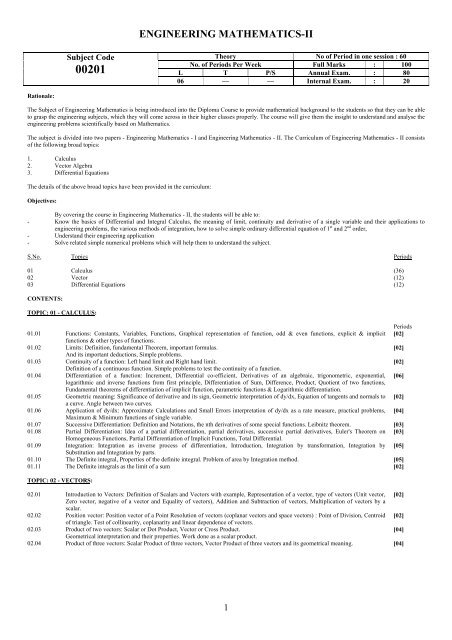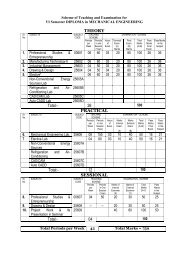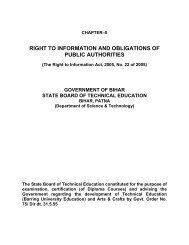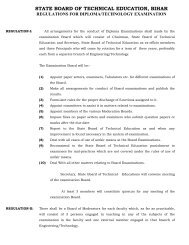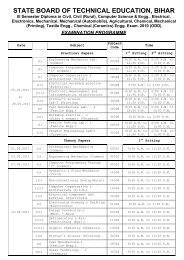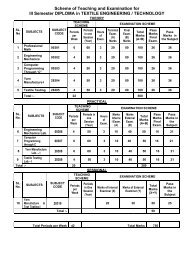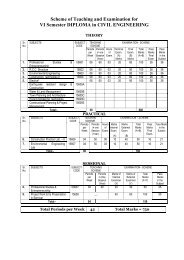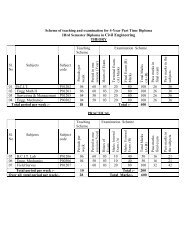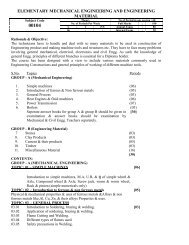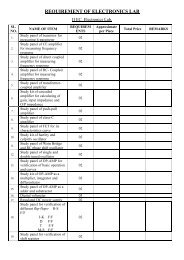00201: Engineering Mathematics - II - SBTE Home Page
00201: Engineering Mathematics - II - SBTE Home Page
00201: Engineering Mathematics - II - SBTE Home Page
You also want an ePaper? Increase the reach of your titles
YUMPU automatically turns print PDFs into web optimized ePapers that Google loves.
ENGINEERING MATHEMATICS-<strong>II</strong><br />
Subject Code<br />
<strong>00201</strong><br />
Theory No of Period in one session : 60<br />
No. of Periods Per Week Full Marks : 100<br />
L T P/S Annual Exam. : 80<br />
06 — — Internal Exam. : 20<br />
Rationale:<br />
The Subject of <strong>Engineering</strong> <strong>Mathematics</strong> is being introduced into the Diploma Course to provide mathematical background to the students so that they can be able<br />
to grasp the engineering subjects, which they will come across in their higher classes properly. The course will give them the insight to understand and analyse the<br />
engineering problems scientifically based on <strong>Mathematics</strong>.<br />
The subject is divided into two papers - <strong>Engineering</strong> <strong>Mathematics</strong> - I and <strong>Engineering</strong> <strong>Mathematics</strong> - <strong>II</strong>. The Curriculum of <strong>Engineering</strong> <strong>Mathematics</strong> - <strong>II</strong> consists<br />
of the following broad topics:<br />
1. Calculus<br />
2. Vector Algebra<br />
3. Differential Equations<br />
The details of the above broad topics have been provided in the curriculum:<br />
Objectives:<br />
By covering the course in <strong>Engineering</strong> <strong>Mathematics</strong> - <strong>II</strong>, the students will be able to:<br />
- Know the basics of Differential and Integral Calculus, the meaning of limit, continuity and derivative of a single variable and their applications to<br />
engineering problems, the various methods of integration, how to solve simple ordinary differential equation of 1 st and 2 nd order,<br />
- Understand their engineering application<br />
- Solve related simple numerical problems which will help them to understand the subject.<br />
S.No. Topics Periods<br />
01 Calculus (36)<br />
02 Vector (12)<br />
03 Differential Equations (12)<br />
CONTENTS:<br />
TOPIC: 01 - CALCULUS:<br />
Periods<br />
01.01 Functions: Constants, Variables, Functions, Graphical representation of function, odd & even functions, explicit & implicit [02]<br />
functions & other types of functions.<br />
01.02 Limits: Definition, fundamental Theorem, important formulas.<br />
[02]<br />
And its important deductions, Simple problems.<br />
01.03 Continuity of a function: Left hand limit and Right hand limit.<br />
[02]<br />
Definition of a continuous function. Simple problems to test the continuity of a function.<br />
01.04 Differentiation of a function: Increment, Differential co-efficient, Derivatives of an algebraic, trigonometric, exponential, [06]<br />
logarithmic and inverse functions from first principle, Differentiation of Sum, Difference, Product, Quotient of two functions,<br />
Fundamental theorems of differentiation of implicit function, parametric functions & Logarithmic differentiation.<br />
01.05 Geometric meaning: Significance of derivative and its sign, Geometric interpretation of dy/dx, Equation of tangents and normals to [02]<br />
a curve. Angle between two curves.<br />
01.06 Application of dy/dx: Approximate Calculations and Small Errors interpretation of dy/dx as a rate measure, practical problems, [04]<br />
Maximum & Minimum functions of single variable.<br />
01.07 Successive Differentiation: Definition and Notations, the nth derivatives of some special functions. Leibnitz theorem. [03]<br />
01.08 Partial Differentiation: Idea of a partial differentiation, partial derivatives, successive partial derivatives, Euler's Theorem on [03]<br />
Homogeneous Functions, Partial Differentiation of Implicit Functions, Total Differential.<br />
01.09 Integration: Integration as inverse process of differentiation, Introduction, Integration by transformation, Integration by [05]<br />
Substitution and Integration by parts.<br />
01.10 The Definite integral, Properties of the definite integral. Problem of area by Integration method. [05]<br />
01.11 The Definite integrals as the limit of a sum [02]<br />
TOPIC: 02 - VECTORS:<br />
02.01 Introduction to Vectors: Definition of Scalars and Vectors with example, Representation of a vector, type of vectors (Unit vector, [02]<br />
Zero vector, negative of a vector and Equality of vectors), Addition and Subtraction of vectors, Multiplication of vectors by a<br />
scalar.<br />
02.02 Position vector: Position vector of a Point Resolution of vectors (coplanar vectors and space vectors) : Point of Division, Centroid [02]<br />
of triangle. Test of collinearity, coplanarity and linear dependence of vectors.<br />
02.03 Product of two vectors: Scalar or Dot Product, Vector or Cross Product.<br />
[04]<br />
Geometrical interpretation and their properties. Work done as a scalar product.<br />
02.04 Product of three vectors: Scalar Product of three vectors, Vector Product of three vectors and its geometrical meaning. [04]<br />
1
TOPIC: 03 - DIFFERENTIAL EQUATION:<br />
03.01 Introduction: Definition of a Differential Equation, Formation of a Differential Equation, Ordinary and Partial Differential<br />
Equation, Order and Degree of a Differential Equation.<br />
03.02 Equation of first Order and first Degree: Solution of different types of equations: (i) Variable separable (ii) Homogeneous<br />
Equations (iii) Equation reducible to homogeneous form (iv) Linear Equations (v) Exact Differential Equations.<br />
03.03 Linear Differential Equations: with constant coefficients of orders two: Definition, complete solution Rules for finding the<br />
complementary function. Rules for finding the particular Integral, Simple Problems.<br />
[01]<br />
[07]<br />
[04]<br />
Books Recommended:<br />
<strong>Engineering</strong> <strong>Mathematics</strong> - <strong>II</strong><br />
1. <strong>Mathematics</strong> for Class XI Part I - NCERT/R. S. Aggawal<br />
2. <strong>Mathematics</strong> for Class XI Part <strong>II</strong> - NCERT/R. S. Aggawal<br />
3. <strong>Mathematics</strong> for Class X<strong>II</strong> Part I - NCERT/R. S. Aggawal<br />
4. <strong>Mathematics</strong> for Class X<strong>II</strong> Part <strong>II</strong> - NCERT/R. S. Aggawal<br />
5. Calculus - Dr. K.C. Sinha/ Laljee Pd./Das & Gupta<br />
6. Vector - Dr. K.C. Sinha/ Laljee Pd./Das & Gupta<br />
7. Differential Equation - Dr. K.C. Sinha/ Laljee Pd./Das & Gupta<br />
Reference Books:<br />
1. <strong>Engineering</strong> <strong>Mathematics</strong> - Part I & Part <strong>II</strong> - H.K. Dass, S. Chand & Co.<br />
2. Polytechnic <strong>Mathematics</strong> for Diploma level<br />
- H.K. Dass, S. Chand & Co.<br />
3. Solid Geometry<br />
- Dr. K.C. Sinha/ Laljee Pd.<br />
S.No. Scheme of Examination Percentage Marks Types of Questions<br />
1. To test the knowledge of the subject 25% 20 Objective type question covering the entire syllabus.<br />
2. To test the understanding & Application of the 75% 60 Short and/ or long answer type<br />
subject<br />
Break-up given as under:<br />
Calculus 60% 48<br />
Vector 20% 16<br />
Differential Equation 20% 16<br />
2


